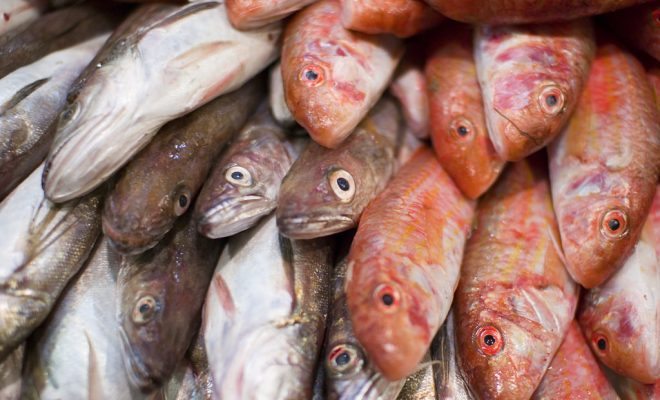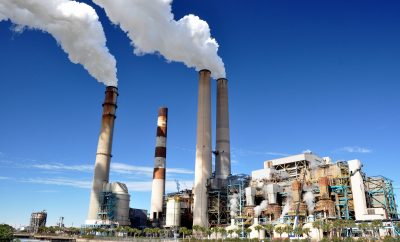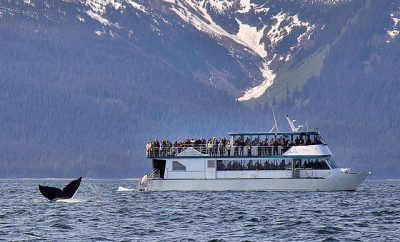 "untitled" courtesy of [Proscilas Moscas via Flickr]
"untitled" courtesy of [Proscilas Moscas via Flickr]
Energy & Environment
Growing Holes in Our Ocean Fisheries
Seafood is the primary source of protein and nutrition for about three billion people worldwide, especially in small island states and poor coastal areas. Fishing is also an important source of income for about 200 million people, with 97 percent of fishers in the developing world. However, as the global population has risen dramatically over the past century, the quantity of fish caught every year has increased as well. Due to the sheer size of the demand for seafood, and the fact that the market generally revolves around a few select kinds of fish, the growth in fishing has caused considerable damage to ocean fisheries.
Many populations of fish have become threatened, and in some areas, they have died off completely. As fish die out, ocean biodiversity suffers and the fishers’ ability to sustain their livelihood is threatened. There are several varying models of exactly how threatened the fish industry is, and there’s often disagreement between conservationist scientists and market experts. Read on to find out more about what exactly is happening with our fisheries and the different possible solutions.
So How Bad is it Exactly?
It is widely accepted that ocean fisheries are over-exploited, although there’s plenty of disagreement on exactly what that means for the future. One of the first major examples of fish stocks losing their stability happened in the Gulf of Maine, where a massive restriction on cod fishing was placed all along the gulf, from Cape Cod to Nova Scotia. The cod stock in the area had dropped to such low levels due to intensive fishing practices that the federal government was forced to scale back the industry in order to save the species. Unfortunately, this also meant that fishers, in order to leave the cod undisturbed, had to reduce their catch of several other species, including pollock, haddock, and hake, because they share the same feeding ground on the ocean floor. This move caused an uproar within coastal communities, many of which depended on fishing as a major source of employment and income for their citizens. Fishing reductions both cut off a local food supply and disrupt a way of life.
The same problem is happening in countless fisheries across the planet, and if a fishery shuts down, similar consequences will be felt in its surrounding areas. This can be particularly disastrous in coastal or island communities in the developing world where fish provide the central or only source of food and employment.
The first major analysis of global fisheries was conducted in 2006 by the marine research ecologist Boris Worm and a team of Stanford researchers. Worm and his team analyzed 48 different marine protected areas and then combined their findings with global catch data from the U.N. Food and Agriculture Organization. As a result, they were able to track the biodiversity of 12 coastal areas over 1,000 years. They found that biodiversity had dropped off rapidly over the last millennium and that the collapse of any given species is likely to disrupt the entire ecosystem, increasing the threat to other species. That pattern has caused the loss of biodiversity to move at a rapid and increasing rate throughout history as we approach the modern day. They predicted that without a massive change in the way we fish and a concerted effort to create more restoration areas for threatened species, all global fisheries would collapse by 2050.
This estimate was almost immediately attacked by fishery scientist Ray Hilborn, who claimed that the projections were widely inaccurate and sensationalist. Two movements, ecologists (who are generally conservationist minded) and fishery scientists (who are generally economically or market-minded) butted heads on their projections for years until remarkably, they decided to work together. Boris Worm, Ray Hilborn, and their teams combined their data sets and evaluation tools to publish a paper together in 2009. The results from their combined efforts show, with some optimism, that several of earth’s ecosystems that were thought to be dying out have been steadily recovering. However, they also calculated that 63 percent of global fish stocks need to be rebuilt, requiring a dramatic reduction in global catch. They advised catch restrictions, modifications, closed off restoration areas, and a reassessment of the fishing methods used by international commercial fleets.
Destructive Fishing Methods
A major reason for our current situation is the way in which we actually fish. As the demand for fish increased over time, innovations in hunting methods progressed rapidly as well. Unfortunately, this led to the widespread use of several highly destructive fishing techniques, such as bottom trawling, purse seining, longline fishing, gillnetting, and a variety of other less commonly used methods.
Longlining involves stringing down weighted lines below fishing ships. Each of these lines is covered with hooks running vertically down the line, which allows for fish to be caught at each point on the line where a hook is attached. These lines can be up to 50 miles long and present the risk of hooking sea turtles, sharks, and aquatic birds because much of the bait is close to the surface. Because of this, experts say that longlines should be sunk at deeper levels to reduce this problem. However, longlining is still in many ways one of the least invasive forms of hunting used by commercial fisheries, whereas the other three methods all make use of giant nets in different ways. Purse seining drags a vertically weighted net in a circle to entrap fish in the center. The circle is eventually drawn smaller and smaller until the fish are trapped. Gillnetting suspends nets underwater with weights on the bottom and buoyed floaters on the top. The nets are made of very thin mesh and are almost invisible, causing many fish to try to swim right through them and get caught. Trawling drags a weighted net along the ocean floor, scooping up anything that it passes over.
The primary problem with these three methods is that they result in high rates of bycatch, which is the catching of fish that are considered to have no commercial value. Fish that are caught but can’t be sold die, which causes huge amounts of unnecessary damage to populations of fish outside of what we actually consume and attempt to hunt for. Trawling, in particular, has come under public scrutiny because the method is uniquely invasive. As the net drags along the ocean floor, not only does it generate huge quantities of bycatch, it also indiscriminately destroys the ecosystem that covers the ocean’s bottom, including ancient animal habitats and coral reefs that have existed for centuries. Trawling is also not to be confused with trolling, a method of fishing with which boats cast lines behind them and tow them forward. This technique primarily attracts a few species of fish–such as salmon, tuna, and mahi-mahi–and follows fast moving targets, resulting in one of the lowest rates of bycatch.
Market Limitations
Problems with bycatch are further compounded by the fact that there are only a few species of fish that are generally hunted and eaten. Actually, as Paul Greenberg notes in his critically acclaimed book, “Four Fish,” the fish market revolves around just four types of fish: salmon, tuna, bass, and cod. (The book also points out that the modern livestock industry has decreased in biodiversity over time and now only revolves around a few major animals as well. The same problem can be seen in agriculture with the increasing prevalence of monocultures that have led many species of vegetables and grains to die out).
Our love of these specific kinds of fish makes them the only species considered commercially viable, and therefore, they are the focus of most fishing. This presents two major problems, the first being that we are exclusively targeting only a few primary species, which is inevitably going to threaten their populations. The second major problem is that countless other fish, which are completely edible but not considered popular, become bycatch during industrial fishing expeditions. As a result, a large amount of marketable fish become waste and their populations can be severely damaged.
This problem is particularly difficult when it comes to animals that are already considered to be threatened are caught in nets, such as certain species of dolphins, sharks, and turtles. There is no specific reason for the exclusive popularity of cod, tuna, salmon, and bass, as plenty of other fish have similar tastes and nutritional values. If humans were to expand their diets and the market responded accordingly, then it would be hypothetically possible to reduce our targeted hunting of threatened species and expand to other, more stable fish stocks.

“Untitled” courtesy of Proscilas Moscas via Flickr
Eating seafood lower down on the food chain, such as clams, anchovies, sardines, and oysters, would generally be a more sustainable method of consumption. Smaller aquatic animals are in much greater numbers and are capable of reproducing at much higher rates than larger fish. This would also lessen the amount of Persistent Organic Pollutants that enter human bodies through fish consumption. POPs, such as methylmercury and PCBs (polychlorinated biphenyls, often used with electrical equipment) enter the ocean ecosystem through pollution and are stored in the fatty tissues of fish. POPs bioaccumulate, meaning that when larger organisms in the ocean eat smaller organisms, they retain all the toxins from their prey. As a result, the largest fish are often the most toxic. POPs can cause serious damage to a person’s organs and nervous system over time. The lower down on the ocean food chain you eat, the more sustainable it is for the biodiversity of the ocean and the lower your risk is of consuming high levels of toxic pollutants.
Aquaculture vs. Open Hunting
Aquaculture has been proposed by many as a solution to some of the current problems with open fishing. Aquaculture is the process of “farming fish” by keeping them in a controlled environment and supplying their diet for them. Currently, aquaculture supplies about 50 percent of the world’s fish and allows fishing companies to both create a high yield of certain stocks and to avoid problems with bycatch. There are a variety of ways to raise fish, both indoors and outdoors, and it’s possible to do so in a way that’s sustainable for the population.
If you raise fish on a vegetarian diet, the cost of input is fairly low. However, in order to gain desirable tastes and the healthy omega-3 fatty acids that customers want out of fish, aquaculture generally raises its animals on a carnivorous diet. This requires fishing for all the food needed to raise these animals to a size large enough to sell. In worst case scenarios, this means that industrial fishing methods are still widely used for aquaculture, but only to collect the food for other fish (although this results in less bycatch and waste since smaller fish are mainly what bigger fish want to eat). Currently, 37 percent of all global seafood isn’t eaten by humans, but is ground into protein feed and fed back to fish or to livestock farm animals.

“Fishing for Tonight’s Dinner..” courtesy of Mark Guadalupe via Flickr
Furthermore, aquaculture often results in the destruction of the ecosystems it is conducted in. The most serious problem with this is the destruction of the mangrove forest, which is a shoreline habitat for many threatened species. Often times, especially in East Asia, mangrove forests will be razed to make way for the construction of an aquaculture farm, causing many threatened species to lose their habitat as a result. These farms also release harmful chemicals into the surrounding environment, including pesticides, veterinary drugs, and untreated waste water.
These problems are at their worst in the areas where aquaculture is the most practiced, such as China, which has environmental regulations that are very lenient. All this is not to say that aquaculture is bad; in fact, aquaculture has great potential to increase the sustainability of the way we utilize our fisheries. However, fish farms have to be created without destroying precious ecosystems, and they have to be run in a way that takes into account the damage that they can inflict on the surrounding areas if their operators aren’t careful.
Conclusion
Fish are not a limitless resource and there are countless things that need to change in the way we fish if humans want to maintain our way of life. Our industrial fishing practices are destructive and cause the large-scale death of fish that we never even eat. Humans are only willing to eat a few select species, and this causes those populations to be severely threatened. The way we currently fish destroys ecosystems and wastes incredible amounts of edible fish as bycatch. We won’t be able to do this forever. After working together, Boris Worm and Ray Hilborn agreed that it’s possible for global fish stocks to survive past 2050–but doing so will require serious changes around the world.
Resources
BBC: How the World’s Oceans Could be Running out of Fish
CNN: A Fishing Way of Life is Threatened
Encyclopedia Britannica: The Pros and Cons of Fish Farming
Environmental Protection Agency: Persistent Organic Pollutants: A Global Issue, A Global Response
Marine Conservation Institute: Destructive Fishing
Mercury News: Lean Year for New England Cod Ahead, Shutdown Looms
Monterey Bay Aquarium Seafood Watch: Fishing and Farming Methods
Nereus Program: Predicting Future Oceans
New Zealand Ministry for Primary Industries: Fishing Methods
The New York Times: Study Finds Hope in Saving Saltwater Fish
The New York Times: Where Have all the Cod Gone?
Salem State University: Benefits of Aquaculture
Science Mag: Rebuilding Global Fisheries
Stanford News: Study Predicts Collapse of All Seafood Fisheries by 2050
United Nations Food and Agriculture Organization: General Situation of World’s Fish Stocks
Paul Greenberg: Four Fish: The Future of the Last Wild Food
World Watch Institute: Eating Sustainable Seafood – Three Tips to Steer Clear of Fisheries Collapse
World Wildlife Fund: Infinite Depths: Protecting Oceans and a Global Seafood Pipeline
World Wildlife Fund: Unsustainable Fishing








Comments